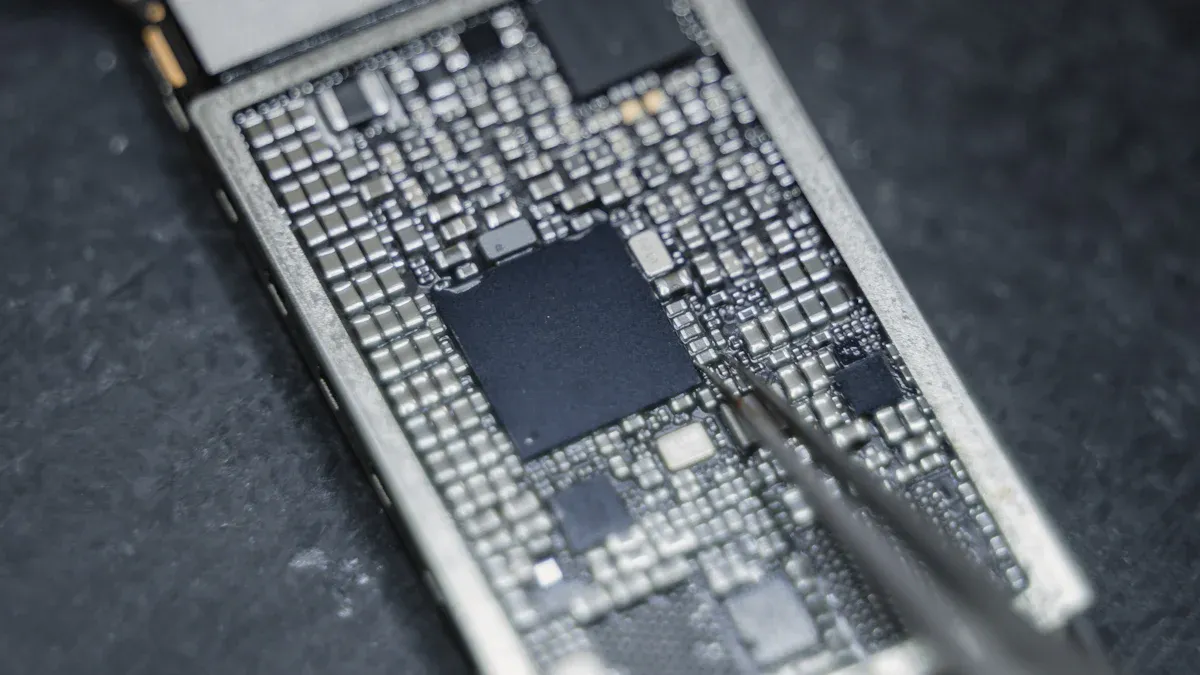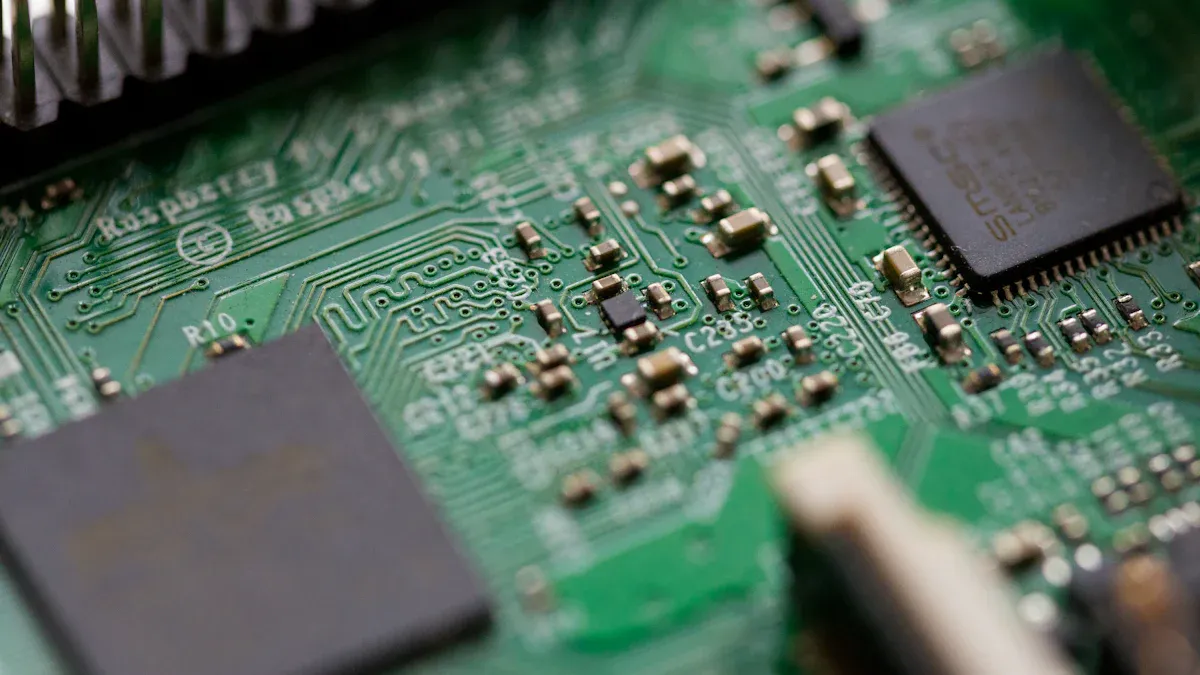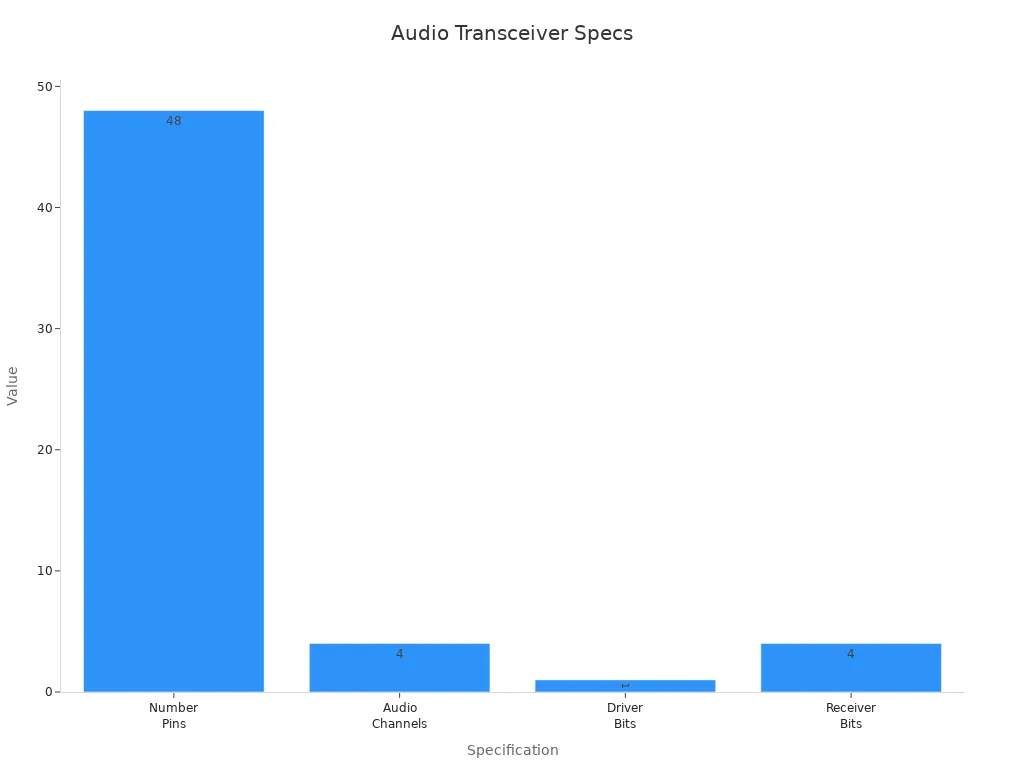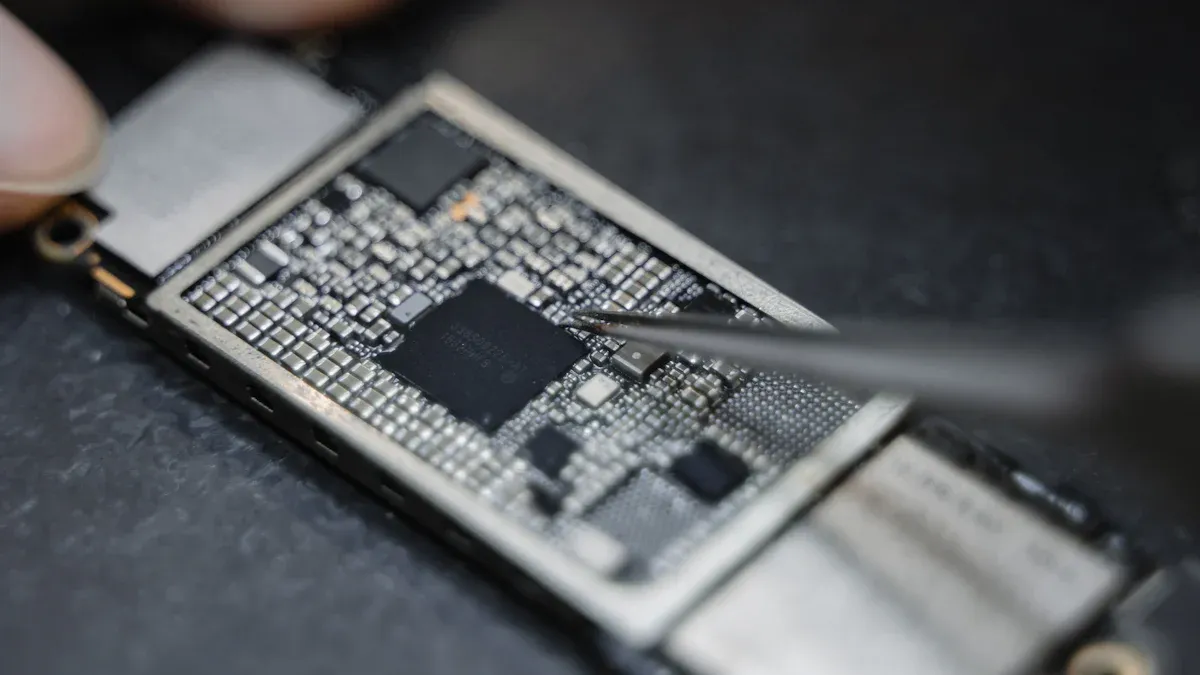What is an Audio Transceiver Chip in a 48TQFP Package and How is it Used

An AUDIO TRANSCEIVER chip 48TQFP is a compact device that sends and receives audio signals in digital and analog systems. This chip uses a 48-pin TQFP package, which helps save space and supports reliable connections in modern electronics. Many devices use these chips because they combine high performance and easy integration.
Parameter | Details |
|---|---|
Package Type | 48-pin LQFP / TQFP |
Maximum Bit Rate | 175 Kbps |
Interface Type | SPI |
Operating Voltage | 3.3 V |
Operating Temperature | Industrial range (down to -40°C) |
Application Domains | Home/building automation, smart energy, street-lighting control |
These features support strong audio quality and wide use in communication systems.
Key Takeaways
An audio transceiver chip in a 48TQFP package sends and receives both analog and digital audio signals, making it versatile for many devices.
The 48TQFP package is small and flat with 48 pins, saving space and allowing easy mounting on circuit boards for compact designs.
These chips support multiple audio channels and work well in tough conditions, such as wide temperature ranges, making them reliable for cars and professional audio.
Standard interfaces like I2C and SPI let engineers connect the chip easily to other parts, enabling fast and stable communication.
Using these chips improves sound quality, reduces noise, and helps create smaller, efficient, and dependable audio systems.
AUDIO TRANSCEIVER Chip 48TQFP Overview

What It Is
An AUDIO TRANSCEIVER chip 48TQFP is a specialized integrated circuit that manages both sending and receiving audio signals. This chip comes in a 48-pin Thin Quad Flat Package (TQFP), which means it has 48 pins arranged around a flat, square body. The compact size allows engineers to fit the chip into small spaces on circuit boards. The chip supports both analog and digital audio, making it useful for many types of audio equipment. The 48TQFP form factor also helps with surface mounting, which is a common method for attaching chips to modern printed circuit boards.
The KSZ8041FTL, for example, is a full transceiver IC in a 48TQFP package, showing that this form factor is widely used in audio and communication systems.
Main Functions
The AUDIO TRANSCEIVER chip 48TQFP performs several important tasks in audio systems:
It converts analog audio signals into digital data using an analog-to-digital converter (ADC).
It changes digital audio data back into analog signals through a digital-to-analog converter (DAC).
It compresses and decompresses audio data to save space and improve efficiency.
It manages communication between different parts of the audio system, such as the CPU, memory, and controllers.
It supports multiple audio channels, which means it can handle several audio streams at once.
Specification | Details |
|---|---|
Package Type | 48-TQFP |
Number of Pins | 48 |
Number of Audio Channels | 4 |
Operating Temperature | -40°C to 85°C (TA) |
Supply Voltage | Nominal 1.8 V, supports up to 3.3 V |
Mounting Type | Surface Mount |
Output Characteristics | 3-STATE output, Differential Output YES |
Interface Types | I2C, SPI |
Logic Functions | Standard logic functions for transceiver |
Output Polarity | True (positive polarity) |
Driver Bits | 1 |
Receiver Bits | 4 |
Applications | Automotive Audio, Professional Audio, High-End PC Sound Cards, S/PDIF Receiver, Audio Mix Consoles, Telecom Systems |
The chip supports popular communication interfaces like I2C and SPI, which help it connect with other devices and controllers.

Key Features
The chip integrates both transmit and receive functions, reducing the need for extra components.
It supports up to four audio channels, making it suitable for stereo and surround sound systems.
The chip works in a wide temperature range, from -40°C to 85°C, which makes it reliable for automotive and industrial uses.
It uses op-amp based peak detectors to improve stability and accuracy in audio signal processing. This helps prevent distortion and keeps sound quality high.
The chip offers 3-STATE and differential outputs, which allow for flexible connections and better noise resistance.
Surface mount design makes it easy to install on modern circuit boards.
The chip can handle both analog and digital audio, including S/PDIF signals, which are common in professional and consumer audio equipment.
Many audio devices, such as mixing consoles and high-end sound cards, use the AUDIO TRANSCEIVER chip 48TQFP because it combines high performance with easy integration.
Package Details

48TQFP Structure
The 48TQFP package stands for "48-pin Thin Quad Flat Package." This package has 48 pins arranged evenly on all four sides of a flat, square body. Each pin connects the chip to the circuit board, allowing signals and power to flow smoothly. The body of the package measures about 7x7 millimeters, making it small enough for compact devices. Engineers often choose this package because it supports surface mounting. Surface mounting means the chip sits directly on the board, which saves space and helps with fast assembly. The 48TQFP package also uses materials that resist corrosion, so the chip stays reliable even in tough environments.
The 48TQFP structure gives designers a way to fit many features into a small area. This helps create smaller, lighter, and more efficient audio devices.
Benefits for Audio Devices
The 48TQFP package offers several advantages for audio devices. Its small size allows manufacturers to build slim products without losing performance. The package supports stable connections, which helps keep audio signals clear and free from noise. Many AUDIO TRANSCEIVER chip 48TQFP models use this package because it handles both analog and digital signals well.
The following tables show how real chips in 48TQFP packages perform in audio applications:
Parameter | AD1886JST (48-LQFP) |
|---|---|
Resolution | |
Dynamic Range (ADC / DAC) | 87 dB / 90 dB |
Number of ADCs / DACs | 2 / 2 |
Sigma-Delta Conversion | Yes |
Supply Voltage (Digital) | 3.0 V to 3.6 V |
Supply Voltage (Analog) | 4.75 V to 5.25 V |
Mounting Type | Surface Mount |
Package Type | 48-LQFP (7x7 mm) |
Operating Temperature | 0°C to 70°C |
Parameter | CS4297-JQ (48-TQFP) |
|---|---|
Resolution | |
Power Consumption | Low (optimized for portable devices) |
Supported Audio Formats | Multiple digital audio data formats |
Integrated ADC | Stereo analog-to-digital converter |
Supply Voltage | 3.135 V to 3.465 V and 4.75 V to 5.25 V |
Mounting Type | Surface Mount |
Package Type | 48-TQFP (7x7 mm) |
Operating Temperature | 0°C to 70°C |
These examples show that the 48TQFP package supports high-resolution audio, low power use, and easy mounting. Devices using this package can deliver strong audio quality and work well in many settings. The package also helps keep the AUDIO TRANSCEIVER chip 48TQFP stable and reliable over time.
Operation
Signal Flow
The AUDIO TRANSCEIVER chip 48TQFP manages both analog and digital audio signals. It receives analog signals from sources like microphones or line-in jacks. These signals pass through analog signal processing blocks, such as amplifiers and filters, which help clean and boost the sound. The chip then uses an analog-to-digital converter (ADC) to turn these continuous signals into digital data. This digital data can be processed, stored, or transmitted to other devices.
When the chip needs to send audio out, it uses a digital-to-analog converter (DAC) to change digital signals back into analog form. This process allows the chip to drive speakers or headphones with clear sound. The chip also supports digital audio formats like S/PDIF, which carry high-quality audio between devices without converting to analog.
Engineers use schematic diagrams with clear symbols for resistors, capacitors, op amps, and logic gates to trace how signals move through the chip. These diagrams help them understand each step in the signal path and ensure the chip works as expected.
Sampling changes analog signals into digital values at regular intervals.
Reconstruction turns digital samples back into smooth analog signals.
Digital signal processing (DSP) inside the chip improves sound quality by reducing noise and correcting errors.
Testing the chip involves both static and dynamic methods. Static tests use simple signals to check for errors in conversion, while dynamic tests use sine waves and Fast Fourier Transform (FFT) analysis to measure sound quality. Engineers look at factors like signal-to-noise ratio (SNR) and total harmonic distortion (THD) to make sure the chip delivers clear audio.
Component/Concept | Description |
|---|---|
Signal Source | Microphones or other devices producing analog signals |
Amplifies and filters incoming analog signals | |
ADC | Converts analog signals to digital data |
DSP | Processes digital audio to improve clarity and reduce noise |
DAC | Converts digital audio back to analog for output |
Codec | Interfaces between analog and digital domains |
Sampling Frequency | Determines how often analog signals are measured (e.g., 44 kHz for CD audio) |
System Integration
The AUDIO TRANSCEIVER chip 48TQFP connects easily with other parts of an audio system. It uses standard communication interfaces like I²C and SPI. These interfaces allow the chip to exchange data with microcontrollers, memory, and other chips. I²C uses two wires and supports multiple devices on the same bus, making it simple and efficient for short distances. SPI uses more wires but can transfer data much faster, which is helpful for high-speed audio streaming.
Feature/Statistic | I²C | SPI |
|---|---|---|
Number of wires | 2 (SCL, SDA) | 4+ (SCLK, MOSI, MISO, SS per slave) |
Data transfer rate | Up to 5 Mbps | Over 100 MHz possible |
Communication type | Half-duplex, synchronous | Full-duplex, synchronous |
Master/Slave configuration | Multi-master supported | Single master only |
Error handling | ACK/NACK bits for error checking | No built-in error checking protocol |
Device addressing | Unique address for each slave | Separate slave select line per device |
Typical use cases | Sensors, EEPROMs, low-speed devices | High-speed data streaming, memory |
Many development tools support these interfaces. For example, host adapters and protocol analyzers help engineers test and debug I²C and SPI connections. These tools can reach speeds up to 80 MHz for SPI and 3.4 MHz for I²C, making them suitable for both simple and advanced audio systems.
The chip also supports multiple audio channels. This means it can handle stereo or surround sound, sending and receiving several audio streams at once. System designers often use hierarchical schematics to organize complex circuits. They break the system into blocks, such as input, processing, and output, and use clear labels to trace signals across the design.
Integrated systems using this chip show strong performance in real-world tests. They deliver reliable power, withstand harsh conditions, and maintain high audio quality for many years.
Integrated fitting systems and objective measures help optimize performance in demanding applications, such as automotive or medical devices.
The chip’s design allows for easy expansion, so engineers can add more features or channels as needed.
The AUDIO TRANSCEIVER chip 48TQFP brings together signal processing, communication, and control in one compact package. This integration makes it a popular choice for modern audio devices.
Applications
Consumer Electronics
Audio transceiver chips play a key role in many consumer electronics. These chips help devices send and receive clear audio signals. People use them in smartphones, tablets, smart speakers, and home entertainment systems. The demand for wireless connectivity in these devices keeps growing.
The RF transceiver chip market was valued at $18.7 billion in 2023 and could reach $45.3 billion by 2032.
Growth comes from more smartphones, IoT devices, and smart home products.
New standards like 5G, Wi-Fi 6, and Bluetooth push manufacturers to make better, smaller chips.
Multi-band transceiver technology gives devices more flexibility and better performance.
Integrated chips save space, lower costs, and use less power, which is important for compact devices.
Consumer electronics rely on these chips for fast data rates, low delays, and strong wireless connections. As more people use mobile and smart home devices, the need for advanced audio transceivers will keep rising.
Professional Audio
Professional audio setups need high-quality sound and reliable connections. Audio transceiver chips support digital audio recorders, mixing desks, and digital audio interfaces. These chips help deliver clear sound in live events, studios, and broadcast settings.
The wireless professional audio equipment market keeps growing. New wireless protocols and better chip designs help meet the needs of live events and corporate settings. Bluetooth LE audio transceivers allow for personal audio, voice communication, and audio sharing. Companies like Texas Instruments design chips with high resolution, low distortion, and wide dynamic range. These features help protect speakers and improve sound quality in microphones, wireless systems, and amplifiers.
Automotive Systems
Automotive systems use audio transceiver chips in infotainment, hands-free calling, and driver-assist features. These chips must work well in tough conditions. They need to handle temperature changes, vibration, and electrical noise.
Automotive transceivers meet strict standards like AEC-Q100, ISO 26262, and IATF 16949.
They pass tests for durability, safety, and electromagnetic compatibility.
Features include protection against over-temperature, over-current, and voltage swings.
Chips work across wide temperature ranges, from -40°C to +125°C.
Companies offer long-term support and quality programs for automotive parts.
These standards ensure that audio transceiver chips in cars remain reliable for many years. Infotainment systems, navigation, and communication features all depend on these chips for clear and stable audio.
Benefits
Performance
Audio transceiver chips in a 48TQFP package offer several important benefits for modern devices. Their compact size allows engineers to fit more features into smaller products. This helps make smartphones, tablets, and audio equipment lighter and easier to carry. The 48TQFP package also supports strong connections, which keeps audio signals clear and reduces noise.
These chips handle both analog and digital signals. They support multiple audio channels, so users can enjoy stereo or surround sound. The design helps keep power use low, which is important for battery-powered devices. Many chips in this package work across a wide temperature range, making them reliable in cars, studios, and homes.
Many engineers choose these chips because they combine high performance, easy integration, and long-term reliability.
Design Considerations
Designers must follow certain guidelines to get the best results from these chips. They need to think about how the chip fits into the whole system. Good design helps prevent problems like noise, signal loss, or overheating.
Sound isolation techniques, such as using mass or decoupling, help reduce unwanted noise.
Careful planning of audio cabling and signal paths keeps signals clean.
Advanced schematic design, including proper layout and grounding, improves performance.
Room acoustics, like absorption and diffusion, matter in studio setups.
System reliability increases with professional installation and regular maintenance.
Designers also need to select the right technology for each project. They should make sure all parts work well together. User needs analysis helps create systems that are easy to use and meet real-world demands. Intuitive interfaces and clear system measurements make operation simple for everyone.
Regular maintenance and accessible technical support help keep audio systems running smoothly for years.
Audio transceiver chips in 48TQFP packages help modern devices send and receive clear sound. These chips offer strong performance, easy integration, and support for both analog and digital signals. Many products use them because they save space and work well in different environments.
Engineers value their reliability and simple design.
Accurate signal processing and stable connections improve sound quality.
Devices with these chips meet high standards for safety and performance.
Choosing these chips can make audio systems more efficient and dependable.
FAQ
What does a 48TQFP package mean?
A 48TQFP package has 48 pins arranged around a thin, square chip. Engineers use this package because it saves space and supports easy mounting on circuit boards.
Can this chip handle both analog and digital audio?
Yes. The audio transceiver chip in a 48TQFP package supports both analog and digital audio signals. It can convert signals between these two types for flexible use.
Why do audio devices need transceiver chips?
Audio devices need transceiver chips to send and receive sound signals. These chips help devices communicate with each other and improve sound quality.
Are these chips used in cars?
Yes. Many cars use audio transceiver chips for infotainment, hands-free calling, and safety alerts. These chips work well in tough conditions and meet automotive standards.
How do engineers connect this chip to other parts?
Engineers use standard interfaces like I²C or SPI to connect the chip to controllers and memory. These connections help the chip share data quickly and reliably.
See Also
A Comprehensive Guide To Logic IC Bus Transceivers
How Communication Chips Function And Their Key Features
Exploring Fast Ethernet Transceiver ICs And Their Operation
Understanding Interface Control Chips And Their Functional Roles
